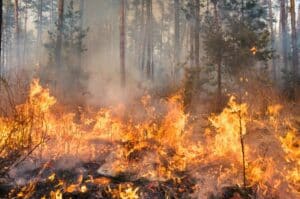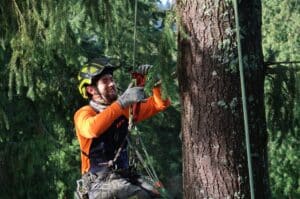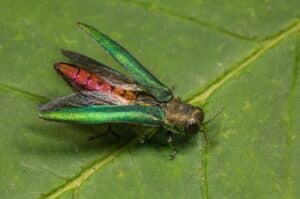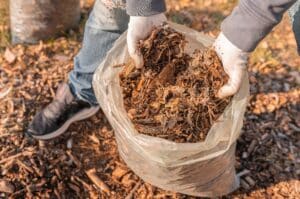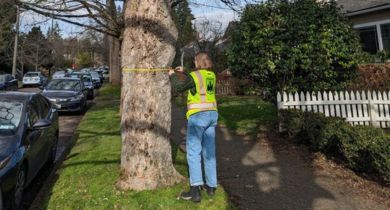How to Maximize Fruit Production: A Guide to Boost Your Seattle Fruit Trees’ Yield
Essential tips to maximize fruit production in Seattle's fruit trees. Discover the vital tree care practices to help your fruit trees produce more and bigger fruit.
With Seattle’s abundant rainfall and mild summer weather, it’s an ideal location for growing many types of fruit trees, including apples, plums, peaches, pears, mulberries, kiwis, persimmons, and figs. If you have fruit trees on your Seattle-area property and you’d like to increase the amount and size of fruit they grow (or the number of spring blossoms), this article will show you how to increase fruit production with proper fruit tree care.
Key Takeaways
- Sunlight and Airflow Are Essential: For healthy fruit tree growth in Seattle’s environment, it’s essential to ensure trees get ample sunlight (6-8 hours daily) and good air circulation, achieved through strategic positioning and canopy management.
- Soil Health and Watering Practices Matter: Regular soil testing and amendments, along with appropriate watering and mulching, are vital for fruit tree fruiting, especially considering Seattle’s unique climate of wet springs and dry summers.
- Seasonal Care is Key: Engaging in specific seasonal activities, such as spring pruning, summer maintenance, and post-harvest care in fall and winter, is essential for the health and productivity of fruit trees in the region.
- Benefits of Dormant Pruning: Pruning during the dormant season, typically late fall to early spring, is crucial for maintaining tree structure, reducing disease spread, and enhancing fruit production.
- Get Professional Care When Needed: Recognizing when professional help is necessary, especially in dealing with local pests, weather challenges, or complex tree issues, can ensure the best care and longevity of fruit trees. Seattle Tree Care’s ISA Certified Arborists provide expert advice and tailored solutions for these challenges.
3 Essential Factors for Productive Fruit Trees
When it comes to keeping your Seattle-area fruit trees healthy and productive there are three main factors that have the biggest impact: sunlight and airflow into the tree canopy, soil quality, and watering.
1. Sunlight and Airflow: The Role of Tree Positioning and Canopy Management
Maintaining fruit tree health in the verdant environment of the Emerald City and surrounding region starts with understanding the critical importance of sunlight and airflow. These two factors are paramount for ensuring vigorous growth and abundant fruit production.
Tree Positioning
The placement of your fruit trees can significantly impact their access to sunlight. Ideally, fruit trees should be positioned to receive full sun, which means at least 6 to 8 hours of direct sunlight daily. This is especially important in areas like Capitol Hill and Bellevue, where urban shading can affect sun exposure.
Canopy Management
Regular pruning plays a crucial role in maintaining an open canopy, which allows sunlight to penetrate and air to circulate freely through the tree. This not only boosts photosynthesis but also helps in reducing the incidence of fungal diseases, common in the moist climate of the Puget Sound area. Strategic pruning, performed by Certified Arborists, ensures that the tree’s structure supports healthy growth and fruit production.
2. Soil Quality: Importance of Soil Testing and Amendments
The health of fruit trees is deeply rooted in the quality of the soil they grow in. The lush landscapes of areas like Mercer Island and Woodway demand particular attention to soil health.
Start with Soil Testing
Before planting or to maintain existing trees, soil testing is an invaluable practice. It provides critical information about soil pH, nutrient levels, and organic matter content. This will help determine which amendments, and how much of each, are needed for optimal tree health.
Add Soil Amendments
Based on soil test results, amending the soil can significantly improve its quality. Organic matter like compost can enhance soil structure, nutrient content, and water retention. Adding specific nutrients, like nitrogen or phosphorus, should be based on soil test recommendations to avoid over-fertilization, which can harm tree health and local ecosystems.
3. Watering Practices: Guidelines for Keeping Fruit Trees Hydrated
Consistent and appropriate watering is essential for fruit trees, particularly during the summer months in the Seattle area.
Watering Guidelines
Young trees require more frequent watering to establish roots, typically once a week, with deeper, less frequent watering as they mature. This encourages deep-root growth, which is essential for tree stability and long-term health.
Applying mulch around the base of fruit trees helps retain soil moisture, regulates temperature, and reduces weed competition. Mulch should be applied while avoiding direct contact with the trunk to prevent rot.
Monitor Moisture Levels
Regularly check soil moisture levels to avoid over or under-watering. This can be done by feeling the soil a few inches below the surface. Additional watering may be necessary during hot spells, particularly in areas farther from the waterfront.
Understanding and implementing these key factors – sunlight and airflow, soil quality, and watering practices – are vital in maintaining the health and productivity of fruit trees in the Seattle region. With the right care, including professional services like those offered by Seattle Tree Care, your fruit trees can thrive, contributing to the beauty and bounty of your property.
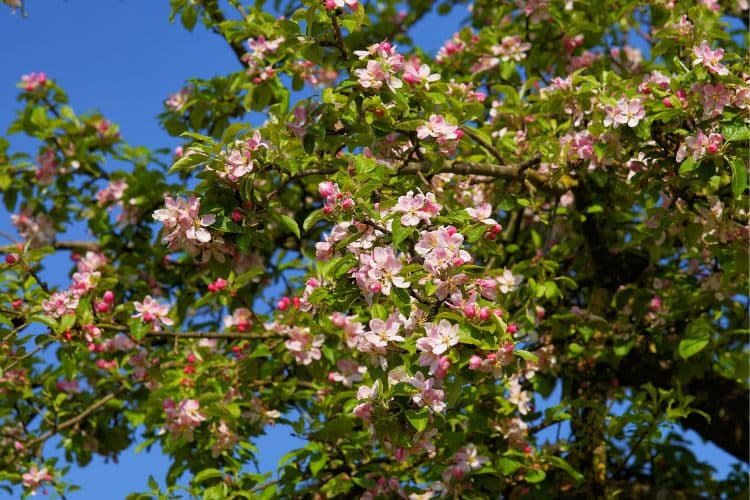
Seasonal Fruit Tree Care in Seattle
Caring for fruit trees in the Seattle region involves a year-round commitment. Each season brings its own set of tasks essential for maintaining the health and productivity of your trees. Here’s a breakdown of what you need to do in each season:
Spring Care: Preparing Trees for the Growing Season
- Inspecting for Pests and Diseases: Early spring is prime time for spotting early signs of pests, such as winter moths, and diseases. Be vigilant and look for any abnormalities on the bark, leaves, and buds.
- Pruning: Late winter to early spring, before bud break, is ideal for pruning. This helps in removing dead or diseased wood and opens up the tree canopy to sunlight and air circulation.
- Fertilization: Apply a balanced fertilizer to provide essential nutrients. However, avoid over-fertilizing as it can lead to more foliage and less fruit.
- Mulching: Refresh mulch around the base of your trees being sure to keep it away from the trunk to prevent root and trunk rot. This helps in retaining moisture and suppressing weeds.
For more information about how and when to fertilize, see our Homeowners Guide to Fertilization.
Summer Maintenance: Mid-Season Tree Care Tips
- Watering: Consistent watering is key during the dryer summer months. Deep watering promotes healthy root growth.
- Thinning Fruit: If your tree is overburdened with fruit, thin them out. This prevents branch damage and ensures the remaining fruits grow to a healthy size.
- Pest Control: Monitor for summer pests and diseases. Timely intervention can prevent widespread damage.
- Sun Protection: On particularly hot days, young fruit trees might need protection from sunburn. If necessary, drape shade cloths over vulnerable trees.
Fall and Winter Practices: Post-Harvest Care and Preparation for Dormancy
- Post-Harvest Pruning: Once the leaves fall, assess your tree’s structure and prune accordingly when your trees are dormant, ideally between late fall and winter before trees bud in the spring. Winter is also a good time for any major structural changes.
- Clean the Area: Clear fallen fruits and leaves to prevent the breeding of pests and diseases.
- Protect Your Trees: In late fall, protect the base of the tree from rodents and other pests. Wrapping the trunk with a tree guard or hardware cloth can be effective.
- Minimize Watering: Water less frequently as the tree goes dormant. However, during dry spells, occasional watering might still be needed.
While these tips will cover the needs of many trees, the specific needs of your fruit trees can vary based on the type and age of the tree, as well as the local Seattle climate and soil conditions. Consulting with a certified arborist from Seattle Tree Care can provide you with tailored advice and services to keep your fruit trees thriving throughout the year.
Just give us a call at 206-789-0534 to schedule a consultation!
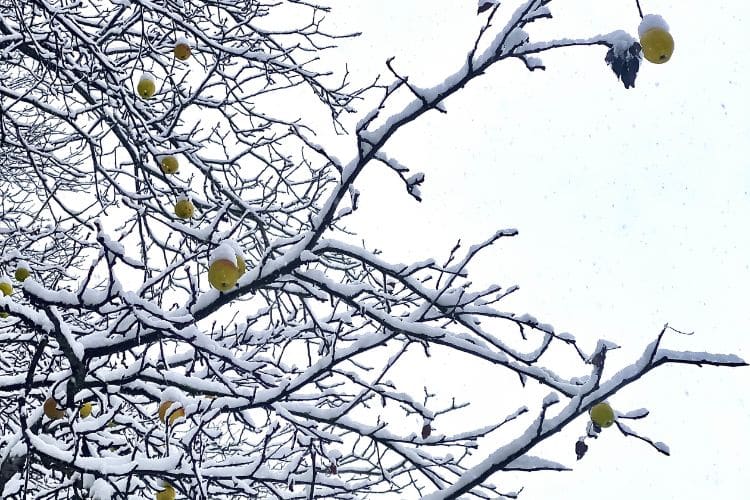
This dormant apple tree awaits spring’s warmth and is ready for pruning to enhance structure and fruit production.
Dormant Pruning for Fruitful Trees
Dormant pruning, an essential tree care practice, involves trimming trees during their dormant season, typically in late fall to early spring. This timing is crucial as it allows for better visibility of the tree structure without leaves, and the tree is less susceptible to stress or disease transmission.
Benefits of Dormant Pruning
- Promotes Healthy Growth: During dormancy, trees are not actively growing, making it an ideal time to prune without harming the tree. This process helps in removing dead or diseased branches, thus promoting healthier growth in the coming season.
- Reduces Disease Spread: Many tree diseases are less active in the colder months, reducing the risk of spreading infections through pruning cuts.
- Enhances Tree Structure: Without foliage, it’s easier to assess and shape the overall structure of the tree, addressing any safety concerns like overhanging branches.
- Improves Aesthetics: Pruning during dormancy prepares trees for lush and balanced growth in spring, enhancing their appearance.
Impact of Dormant Pruning on Fruit Production
- Stimulates Fruit Production: For fruit trees, dormant pruning is particularly beneficial as it stimulates the growth of new fruiting wood.
- Increases Fruit Size and Quality: By removing excess branches, more energy is directed to the remaining branches, potentially improving fruit size and quality.
- Disease Management: Pruning out diseased or pest-infested branches during dormancy can help in controlling fruit tree diseases and pests.
Best Practices for Dormant Pruning of Fruit Trees in the Seattle Region
By including dormant pruning as part of your fruit tree care regimen, you not only ensure the health and productivity of your fruit trees but also contribute to the overall safety and aesthetic of your property. The key is to follow these best practices when doing dormant fruit tree pruning.
- Timing is Key: In the Seattle region, the ideal time for dormant pruning is between late fall and before the buds swell in early spring.
- Use Proper Tools: Ensure that pruning tools are sharp and clean to make precise cuts and prevent the spread of disease.
- Prune Selectively: Focus on removing dead, diseased, or damaged branches, as well as any that cross or rub against each other.
- Consider Tree Species: Different fruit tree species may have specific pruning needs or times. For example, some trees, like cherry and apricot, are best pruned in late summer to prevent disease.
- Safety First: For large trees or high branches, it’s safer and more effective to hire professionals like Seattle Tree Care’s ISA Certified Arborists, who have the right equipment and expertise to do the work correctly and safely.
- Compliance with Local Codes: Be aware of Seattle’s tree care regulations, especially the new restrictive tree code that impacts tree removal.
Common Challenges in Fruit Tree Care
Fruit tree care in the Greater Seattle and King County area comes with a unique set of challenges, primarily due to local pests and varying weather conditions. Understanding these challenges and tackling them effectively is key to maintaining healthy and productive fruit trees.
Local Fruit Tree Pests
The Seattle area sees a range of pests that attack fruit trees, such as apple maggots, codling moths, and aphids. These pests can damage fruit, weaken trees, and in severe cases, lead to tree death. An infestation by pests like these will result in fewer, smaller, and often inedible, fruit.
Keeping an eye on your trees for early signs of pests or diseases – and then quickly taking action to prevent the issue from spreading – can make a big difference. Beyond that, a regular tree health management program will go a long way in keeping your fruit trees producing delicious healthy fruit.
Integrated Pest Management (IPM) programs offered by local arborists like Seattle Tree Care can help reduce pest pressure and prevent disease outbreaks. This approach includes a variety of tree health-enhancing methods, such as using traps for pests, applying organic pesticides when necessary, and encouraging natural predators. See which fruit tree pests we can help you with >>
Unpredictable Weather Conditions
Our region’s weather can be unpredictable, with wet springs and dry summers affecting tree health. Excess moisture can lead to fungal diseases, while dry conditions can stress trees, reducing their yield and vigor.
Ensure proper drainage and placement of irrigation systems to combat excessive soil moisture and use organic mulch to retain moisture during dry periods.
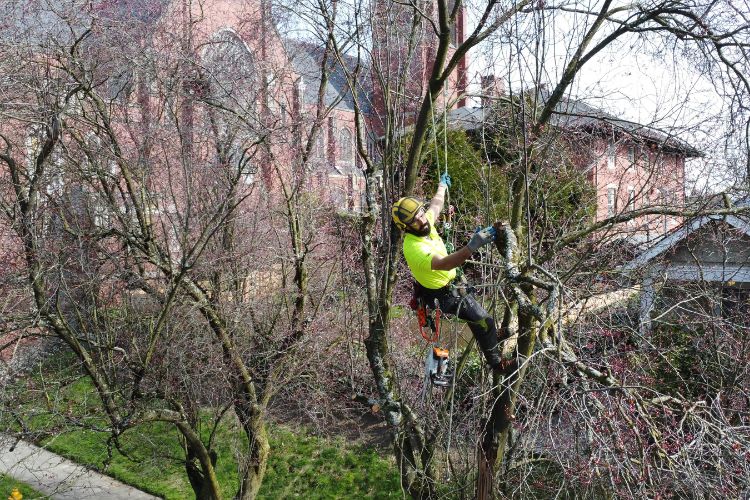
Expert in action: Our Seattle Tree Care specialist meticulously prunes a fruit tree to guide its development and fruiting.
When to Call a Professional
Sometimes, the care fruit trees require goes beyond basic maintenance, and that’s where professionals like Seattle Tree Care come in. Recognizing when it’s time to call in the experts can save you time and ensure your fruit trees get the best care possible.
If you notice abnormal leaf discoloration, unusual growth patterns, or signs of severe pest infestation, or structural issues like broken branches or risk of falling trees are present, it’s time to call for professional assistance.
Ensure the Health and Vitality of Your Fruit Trees
Caring for fruit trees in the Seattle area requires a blend of knowledge, vigilance, and proactive measures. Comprehensive care is essential for tree health and productivity, from addressing common pests and weather-related challenges to knowing when to call in the experts.
If you’re facing challenges with your fruit trees or simply want to ensure they receive the best possible care from a registered tree service provider, don’t hesitate to reach out to Seattle Tree Care at 206-789-0534. Our team of experienced professionals is here to provide expert advice and services tailored to your fruit trees’ specific needs.
Call us today for a consultation (or contact us online) and take the first step towards thriving fruit trees!
Frequently Asked Questions About Fruit Tree Care in Seattle
Q. Can fruit trees in Seattle thrive without regular fertilization?
A. While some fruit trees can grow without regular fertilization, optimal health and productivity usually require a balanced fertilization regime. This is especially true in urban and suburban settings where soil nutrients may be less abundant.
Q. Are there specific fruit tree varieties that are more suitable for Seattle’s climate?
A. Yes, certain varieties are better adapted to Seattle’s climate. For example, apple varieties like Honeycrisp and Gravenstein, and cherry varieties like Rainier and Bing, are well-suited to our local weather conditions.
Q. How often should fruit trees be pruned in the Seattle area?
A. Fruit trees in Seattle typically benefit from annual pruning. The best time to prune is late winter or early spring before new growth starts. This helps ensure the trees’ health, shape, and productivity.
Q. Is it necessary to apply pest control treatments to fruit trees in Seattle?
A. Pest control can be crucial for some fruit trees in Seattle due to local pests like apple maggots and coddling moths. Integrated pest management strategies, including both organic and conventional methods, can be effective.
Q. Can I plant fruit trees in shaded areas of my Seattle property?
A. Fruit trees generally require full sun to produce well. They need at least 6-8 hours of direct sunlight daily. Shaded areas can lead to reduced fruit yield and increased susceptibility to diseases.
Recent Articles
Looking for More?
We've got you covered with tips, resources, updates, how-to's, and other helpful information about trees and landscapes in Seattle, Puget Sound, and King County, WA. Join the thousands of smart local residents who get the monthly newsletter from Seattle Tree Care for helpful information you won't want to miss!
There's no spam - we promise! We are committed to keeping your e-mail address confidential. We do not sell, rent, or lease our contact data or lists to third parties.


